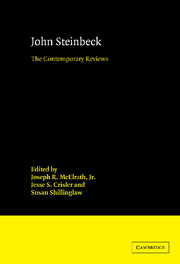Book contents
- Frontmatter
- Contents
- Series Editor's Preface
- Introduction
- 1 Cup of Gold (1929)
- 2 The Pastures of Heaven (1932)
- 3 To a God Unknown (1933)
- 4 Tortilla Flat (1935)
- 5 In Dubious Battle (1936)
- 6 Of Mice and Men (the novel, 1937)
- 7 The Red Pony (1937)
- 8 Of Mice and Men (the play, 1937)
- 9 The Long Valley (1938)
- 10 The Grapes of Wrath (1939)
- 11 The Forgotten Village (1941)
- 12 Sea of Cortez (1941)
- 13 The Moon Is Down (the novel, 1942)
- 14 The Moon Is Down (the play, 1942)
- 15 Bombs Away (1942)
- 16 Cannery Row (1945)
- 17 The Wayward Bus (1947)
- 18 The Pearl (1947)
- 19 A Russian Journal (1948)
- 20 Burning Bright (the novel, 1950)
- 21 Burning Bright (the play, 1950)
- 22 The Log from the Sea of Cortez (1951)
- 23 East of Eden (1952)
- 24 Sweet Thursday (1954)
- 25 The Short Reign of Pippin IV (1957)
- 26 Once There Was a War (1958)
- 27 The Winter of Our Discontent (1961)
- 28 Travels with Charley in Search of America (1962)
- 29 America and Americans (1966)
- 30 Journal of a Novel: The East of Eden Letters (1969)
- 31 The Acts of King Arthur and His Noble Knights (1976)
- 32 Working Days: The Journals of The Grapes of Wrath 1938–1941 (1989)
- Index
15 - Bombs Away (1942)
Published online by Cambridge University Press: 03 May 2010
- Frontmatter
- Contents
- Series Editor's Preface
- Introduction
- 1 Cup of Gold (1929)
- 2 The Pastures of Heaven (1932)
- 3 To a God Unknown (1933)
- 4 Tortilla Flat (1935)
- 5 In Dubious Battle (1936)
- 6 Of Mice and Men (the novel, 1937)
- 7 The Red Pony (1937)
- 8 Of Mice and Men (the play, 1937)
- 9 The Long Valley (1938)
- 10 The Grapes of Wrath (1939)
- 11 The Forgotten Village (1941)
- 12 Sea of Cortez (1941)
- 13 The Moon Is Down (the novel, 1942)
- 14 The Moon Is Down (the play, 1942)
- 15 Bombs Away (1942)
- 16 Cannery Row (1945)
- 17 The Wayward Bus (1947)
- 18 The Pearl (1947)
- 19 A Russian Journal (1948)
- 20 Burning Bright (the novel, 1950)
- 21 Burning Bright (the play, 1950)
- 22 The Log from the Sea of Cortez (1951)
- 23 East of Eden (1952)
- 24 Sweet Thursday (1954)
- 25 The Short Reign of Pippin IV (1957)
- 26 Once There Was a War (1958)
- 27 The Winter of Our Discontent (1961)
- 28 Travels with Charley in Search of America (1962)
- 29 America and Americans (1966)
- 30 Journal of a Novel: The East of Eden Letters (1969)
- 31 The Acts of King Arthur and His Noble Knights (1976)
- 32 Working Days: The Journals of The Grapes of Wrath 1938–1941 (1989)
- Index
Summary
Joseph Henry Jackson.
“The Bookman's Notebook.”
San Francisco Chronicle,
26 November 1942, p. 11Y.
Since the move into Africa, Americans have become more than ever conscious of the great bombing planes that have been coming off the production lines for months past. The terms “Fortress” and “Liberator” are common words today; we regard those magnificent engines of destruction almost with affection.
The fact is, however, that we know more about the planes themselves than about the men who operate them. There have been magazine articles—a few—and there have been some newspaper stories. But until now the whole extraordinary story hasn't been told.
John Steinbeck's new book tells that story. Bombs Away… is its title. It's no romance, no fictionized yarn, but a book of actualities, written specifically at the request of the U. S. Air Forces. To write it, Steinbeck toured for months, visiting training fields all over the country. With him went John Swope, himself a flyer, to take the 60 fine photographs that illustrate the book. Text and photographs together, this is as completely American a book as the war has produced. It's the story of something very specially and peculiarly U. S. A. In a way it epitomized America at war—as you'll see the moment you open it.
There are six jobs that make up a bomber crew, six tasks that must be performed with all the precision, all the elan of, for example, a crack basketball team executing a carefully thought-out play.
The men that do these jobs are the pilot, the navigator, the bombardier, the crew chief, the gunner, the radio man.
- Type
- Chapter
- Information
- John SteinbeckThe Contemporary Reviews, pp. 257 - 268Publisher: Cambridge University PressPrint publication year: 1996



